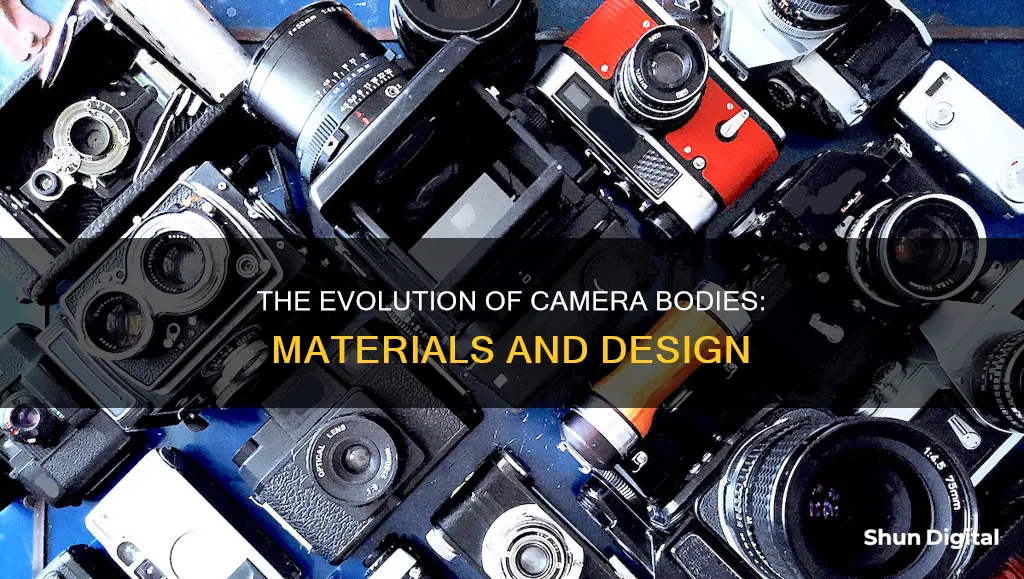
Cameras have come a long way since their invention in the 19th century, evolving from the camera obscura to modern digital cameras and camera phones. The basic components of a camera include an optical element (the lens), a chemical or digital element (the film or image sensor), and a mechanical element (the camera body).
Camera bodies are typically made of plastic, metal, or composite materials. Plastic cameras are more economical to manufacture and can be moulded into various shapes, offering ergonomic benefits over metal cameras. Older cameras tend to be made of die-cast metal alloys, while modern cameras often use plastic or composite materials. Some camera manufacturers have experimented with alternative materials, such as compressed wood, which is harder than polycarbonate and can enhance the aesthetic value of the product.
Lenses, a crucial component of cameras, are typically made of high-quality glass designed to focus light onto the film or image sensor. A camera lens is usually constructed from multiple lens elements to reduce optical aberrations and distortions, improving image quality.
| Characteristics | Values |
|---|---|
| Materials | Plastic, metal, glass, rubber, and electronic components |
| Lens | Glass or plastic |
| Diaphragm | Fixed lens, or adjustable aperture |
| Shutter | Metal leaves, or cloth curtains |
| Shutter speed | Adjustable |
| Body | Polycarbonate compound with glass fiber |
| Viewfinder | Optical glass, plastic, or a combination of both |
| LCD screen | Provides information to the photographer |
What You'll Learn

Camera bodies are made of polycarbonate compounds
Today, the metal light box has been replaced by more rugged composites made by combining one or several different engineering-grade plastics, such as Nylon 6-6 or Ultra-high-molecular-weight polyethylene, with other materials.
Polycarbonate camera bodies are not only durable but also lightweight. They are also corrosion-resistant, which is a desired property when shooting in the rain or near water. They can also withstand high temperatures, which is helpful when shooting in extreme conditions. Although polycarbonate is a strong plastic, it is not as heavy as an aluminium body.
Modern Warfare Mod: Wireless Camera Placement Strategies
You may want to see also

Lenses are made of glass or plastic
Glass lenses are responsible for bending and focusing light onto the camera sensor. They refract and converge light, allowing for precise control over the image-forming process. The front element of a lens is critical to its performance. It is usually coated to reduce abrasion, flare, and surface reflectance and to adjust the colour balance.
While glass is the most common material for lens elements due to its good optical properties and resistance to scratching, other materials are also used, such as quartz glass, fluorite, and plastics like acrylic (Plexiglass). Plastics allow the manufacturing of strongly aspherical lens elements that are difficult or impossible to manufacture in glass. They simplify or improve lens manufacturing and performance. However, plastics are not typically used for the outermost elements of lenses, as they scratch easily.
In recent years, technological advancements have led to the exploration of alternative materials for camera lenses. High-quality plastics and composite materials are being used for certain lens components, contributing to lightweight designs without compromising optical quality.
Waterproof Camera Secrets: How Are They Made?
You may want to see also

Cameras contain metal parts
The history of the camera dates back to the camera obscura, which was essentially a room or a tent with a hole that let in light to create an upside-down reflection. The first portable cameras were boxes with lenses at the front and plates at the back that were covered with light-sensitive materials. Early cameras required exposure times of several seconds or even minutes due to the poor sensitivity of the plates.
The invention of roll film by George Eastman in 1889 revolutionized photography by making it more portable. Cameras and photographers no longer needed to carry heavy plates and chemicals. This led to the development of pocket-sized and point-and-shoot cameras, as well as complex professional equipment.
Today, cameras are made with various materials, including polycarbonate compounds for the camera chassis or body, which provides durability and shock resistance. The shutter, on the other hand, can be made of metal leaves that open and close to control the exposure time.
The use of metal in cameras is not limited to their internal components. Vintage camera tripods, for example, are often made of metal, with some designed to be collapsible or telescoping for added portability.
In summary, metal plays a significant role in the construction of cameras, both in their internal mechanisms and external accessories, contributing to the durability, functionality, and versatility of these devices.
Charging 12V Camera Batteries: A Step-by-Step Guide
You may want to see also

Cameras are recyclable
Recycling cameras offer several benefits. It helps reduce electronic waste, which is a growing concern and affects the environment in various ways. Electronic devices contain toxic elements such as lead, mercury, and cadmium that can cause pollution and contaminate soil and water if not disposed of properly. By recycling cameras, we can also prolong the usable life of their parts, conserve resources, and support organizations dedicated to environmental protection. Additionally, recycling cameras ensure that valuable materials are not wasted, reducing the need for mining and extracting new metals and parts.
Cameras are typically made of plastic and metal materials, both of which are recyclable. Other recyclable materials found in cameras include glass lenses, circuit boards, rubber components, and batteries. When recycled, cameras are dismantled, and these components are separated and sorted into different material categories for further processing. These recycled materials can then be used to produce new products, such as new cameras, toys, and furniture.
While recycling is important, it is also crucial to reduce and reuse whenever possible. Disposable cameras, for example, have long been controversial due to their intended single-use nature, often ending up in landfills. To address this issue, some companies like Flashback are creating alternatives that combine the best of disposable and digital photography without the environmental waste. Additionally, major manufacturers like Kodak and Fujifilm have introduced recycling programs for their disposable cameras, although these programs only recycle the plastic components and may not address the electronic waste issue comprehensively.
Charging Camera Batteries: Alternative Methods to Try
You may want to see also

Cameras have shutters made of different materials
The shutter is a crucial component of a camera, controlling the exposure time or the duration for which light is allowed to reach the film or digital image sensor. Modern camera shutters come in two primary types: leaf shutters and focal-plane shutters, each with distinct designs and functionalities.
Leaf shutters, also known as diaphragm or iris shutters, are typically positioned between or behind the lens components. They consist of overlapping metal blades that open and close either through spring action or electronically. The number of blades can vary, with odd numbers like 3 or 5 being more common. The more blades a leaf shutter has, the more circular the aperture becomes. This type of shutter is often found in medium-format cameras, which are used by a small percentage of professional photographers due to their high cost.
Focal-plane shutters, on the other hand, are located directly in front of the image plane or sensor. They are made up of a pair of overlapping blinds or curtains that form an adjustable slit or window. Driven by a spring or electronic mechanism, the slit moves across the film or sensor to expose it to light. The width of this slit determines the exposure time, with narrower slits resulting in shorter exposures. Focal-plane shutters are commonly found in digital SLRs and are known for their faster shutter speeds compared to leaf shutters.
In addition to these two main types, some cameras also feature electronic shutters, which offer faster shutter speeds and silent operation. Unlike mechanical shutters, electronic shutters do not have moving parts and rely on turning the sensor on and off to capture the exposure. They are found in both cheaper and more expensive cameras, providing exceptional accuracy when designed with precision.
The choice of shutter type and material depends on various factors, including desired exposure time, camera type, and cost. By utilising different shutter materials and designs, photographers can capture a diverse range of images, from high-speed action shots to well-lit landscapes.
Unlocking the P30 Camera: Exploring the Different Modes
You may want to see also
Frequently asked questions
Most cameras are made of plastic and metal materials, with some glass elements.
Camera lenses are typically made from high-quality glass. Some lenses may also be made of plastic.
Camera bodies are often made of a polycarbonate compound, containing 10-20% glass fibre.







